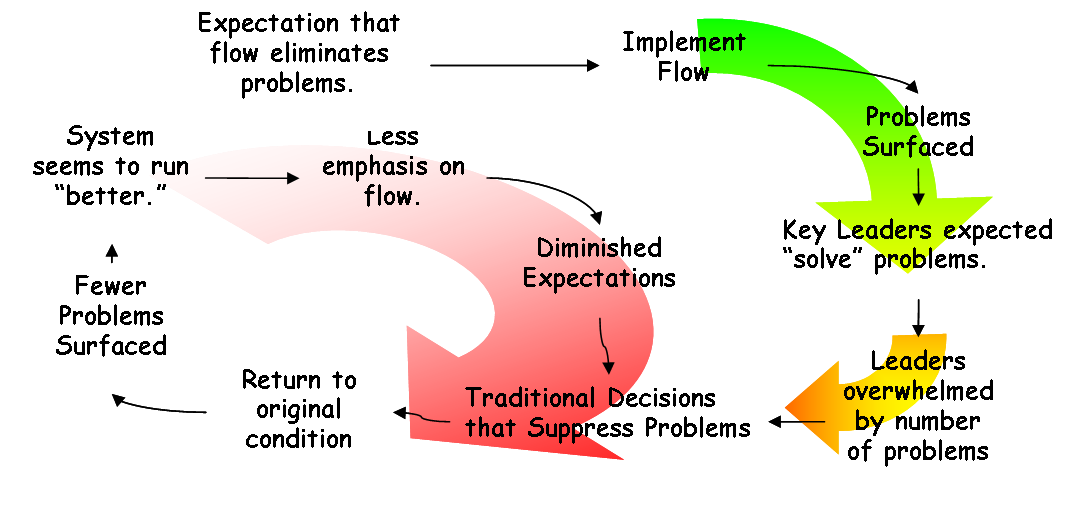On a world-class automobile assembly line, the actual work is continuously being compared to the planned work. In each work zone, there is a planned sequence of tasks which are expected to produce a specified output.
If there is any departure at all from the planned sequence, if things get behind the planned timeline, if the necessary conditions are not there, if any process step does not complete as required then either the Team Member or an automated system turns on a help call – an andon.
The response is immediate. The first response is within seconds with a priority of clearing the problem. The line itself is still moving, but if the problem is not cleared before the end of the takt time the line automatically stops – things go from “yellow” to “red.” When that happens, the responsibility for the problem also shifts up a level in the response chain.
The priority is still to clear the problem quickly – and clearing the problem means to restore conditions required for safety and quality without compromise.
Once the problem is cleared, and the line re-started, the rest of the problem solving process engages to find the cause of the problem and address it in the system itself. If the problem is outside of the bounds, or outside of the capability, of the original Team Leader to solve, then his chain-of-support will engage to help him solve it so that his skills can be improved.
In summary – we have a sequence of tasks to be accomplished over about six hours that, in the end, will result in a car. That sequence of tasks is further broken down into sub-intervals where progress against the plan is checked. If problems develop, the system responds, swarms the problem to clear it, understand it, and adjust the process if necessary.
None of the above should be a surprise.
But what happens in your management monthly reviews?
Huh? How are management monthly reviews related to an assembly line?
Let’s see. In a reasonably functional organization the business plan is (or should be!) a series of tasks to be accomplished over a period of time that, in the end, will deliver specified results. That sequence of tasks is further broken down into sub-intervals where progress of the plan is checked.
But in a typical monthly review, the analogy ends there. When problems develop, the reasons are discussed, mentioned, and worked around. In dysfunctional organizations only the objectives are discussed, and in truly dysfunctional organizations the objectives themselves are adjusted to match what is accomplished.
Shift your thinking a bit, and apply the assembly line analogy to its end-state.
The monthly review is the fixed-stop position. Up to this point, the person responsible for the task “owns” it. He should be checking progress and ensuring that things are getting done as specified, and that the results being achieved are as anticipated (predicted). He should be monitoring conditions and making sure that the operating assumptions are holding. Ideally those checks are built-in to the process and planning so that they are at least semi-automatic.
If all is “green” going into the monthly review, then things are great.
But if something is “off” – yellow – that is equivalent to an andon call. The responsible person is that first-responder. He has until the next review to clear the problem. Think about the ramifications here. This means that if the reviews with the boss are every month, the responsible manager better not wait until the week before to find out what is happening so he can report on it. He has to stay in touch with what is happening.
The monthly review is the fixed-stop-position at the review, and the “andon” goes red.
The reviewing manager now “owns” the problem. His job is now to ensure that there are effective countermeasures in place to get things back on track. That does not absolve the responsible manager, but rather, this becomes a “check” and an “act” for his professional development by the more senior leader.
Again, think of the ramifications. The responsible manager must not only be in touch with what is happening, he also needs to make sure his people are being developed and pushed to fully understand the problems as they occur.
The job of these leaders, at each level, is not only to keep intimately in touch with what is going on, but also be fully aware of the skills, gaps and development of their people. If someone should be able to handle an issue, but can’t, that is a skill gap that, like any other gap, must be addressed (in this case by developing the person).
In mediocre organizations, professional development is owned and overseen by H.R. and may be tied to the annual review process. In organizations that “get it” professional development is a natural part of the leadership process, and happens at all levels in the natural course of getting things done.
